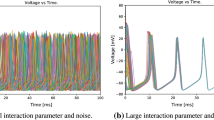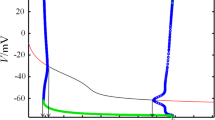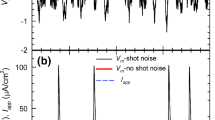Abstract
Toxins, such as tetraethylammonium (TEA) and tetrodotoxin (TTX), can make potassium or sodium ion channels poisoned, respectively, and hence reduce the number of working ion channels and lead to the diminishment of conductance. In this paper, we have studied by numerical simulations the effects of sodium and potassium ion channel poisoning on the collective spiking activity of an array of coupled stochastic Hodgkin-Huxley (HH) neurons. It is found for a given number of neurons sodium or potassium ion channel block can either enhance or reduce the collective spiking regularity, depending on the membrane patch size. For a given smaller or larger patch size, potassium and sodium ion channel block can reduce or enhance the collective spiking regularity, but they have different patch size ranges for the transformation. This result shows that sodium or potassium ion channel block might have different effects on the collective spiking activity in coupled HH neurons from the effects for a single neuron, which represents the interplay among the diminishment of maximal conductance and the increase of channel noise strength due to the channel blocks, as well as the bi-directional coupling between the neurons.
Similar content being viewed by others
References
Hodgkin A L, Huxley A F. A quantitative description of membrane current and its application to conduction and excitation in nerve. J Physiol, 1952, 117: 500–544
Lecar H, Nossal R. Theory of threshold fluctuations in nerves. Biophys J, 1971, 11: 1048–1067
White J A, Rubinstein J T, Kay A. R. Channel noise in neurons. Trends Neurosci, 2000, 23: 131–137
Koch K. Biophysics of Computation: Informational Processing in Single Neurons. New York: Oxford University Press. 1999
van Rossum M C W, O’Brien B J, Smith R G. Effects of noise on the spike timing precision of retinal ganglion cells. J Neurophys, 2003, 89: 2406–2419
Skaugen E, Walløe L. Firing behavior in a stochastic nerve membrane model based upon the Hodgkin-Huxley equations. Acta Physiol Scand, 1979, 107: 343–363
Clay J R, DeFelice L J. Relationship between membrane excitability and single channel open-close kinetics. Biophys J 1983, 42: 151–157
Strassberg A F, DeFelice L J. Limitations of the Hodgkin-Huxley formalism—effects of single-channel kinetics on trans-membrane voltage dynamics. Neural Comput 1993, 5: 843–855
DeFelice L J, Isaac A. Chaotic states in a random world-relationship between the nonlinear differential equations of excitability and the stochastic properties of ion channels. J Stat Phys, 1993, 70: 339–354
Fox R F, Lu Y. Emergent collective behavior in large numbers of globally coupled independently stochastic ion channels. Phys Rev E, 1994, 49: 3421–3431
Chow C C, White J A. Spontaneous action potentials due to channel fluctuations. Biophys J, 1996, 71: 3013–3021
Schneidman E, Freedman B, Segev I. Ion channel stochasticity may be critical in determining the reliability and precision of spike timing. Neuronal Comput, 1998, 10: 1679–1694
Bezrukov S M, Vodyanoy I. Noise-induced enhancement of signal-transduction across voltage-dependent ion channels. Nature, 1995, 378: 362–364
Bezrukov S M, Vodyanoy I. Signal transduction across alamethicin ion channels in the presence of noise. Biophys J, 1997, 73: 2456–2464
Schmid G, Goychuk I, Hänggi P. Stochastic resonance as a collective property of ion channel assemblies. Europhys Lett, 2001, 56: 22–28
Jung P, Shuai J W. Optimal sizes of ion channel clusters. Europhys Lett, 2001, 56: 29–35
Gammaitoni L, Hänggi P, Jung P, Marchesoni F. Stochastic resonance. Rev Mod Phys, 1998, 70: 223–287
Hänggi P. Stochastic resonance in biology-how noise can enhance detection of weak signals and help improve biological information processing. ChemPhysChem, 2002, 3: 285–290
Shuai J W, Jung P. Optimal ion channel clustering for intracellular calcium signaling. Proc Natl Acad Sci, 2003, 100: 506–510
Ginzburg S L, Pustovoit M A. Bursting dynamics of a model neuron induced by intrinsic channel noise. Fluct Noise Lett, 2003, 3: L265–L274
Schmid G, Goychuk I, Hänggi P, Zeng S, Jung P. Stochastic resonance and optimal clustering for assemblies of ion channels. Fluct Noise Lett, 2004, 4: L33–L42
Gong Y B, Wang M S, Hou Z H, Xin H W. Optimal spike coherence and synchronization on complex Hodgkin-Huxley neuron networks. ChemPhysChem, 2005, 6: 1042–1047
Shuai J W, Jung P. The dynamics of small excitable ion channel clusters. Chaos, 2006, 16: 026104
Li Y P, Li Q S. Implicit and explicit internal signal stochastic resonance in calcium ion oscillations. Chem Phys Lett, 2006, 417: 498–502
Schmid G, Goychuk I, Hänggi P. Channel noise and synchronization in excitable membranes. Physica A, 2003, 325: 165–175
Wang M S, Hou Z H, Xin H W. Double-system-size resonance for spiking activity of coupled Hodgkin-Huxley neurons. ChemPhysChem, 2004, 5: 1602–1605
Schmid G, Goychuk I, Hänggi P. Effect of channel block on the spiking activity of excitable membranes in a stochastic Hodgkin-Huxley model. Phys Bio, 2004, 1: 61–66
Schmid G, Goychuk I, Hänggi P. Controlling the spiking activity in excitable membranes via poisoning. Physica A, 2004, 344: 665–670
Schmid G, Goychuk I, Hänggi P. Capacitance fluctuations causing channel noise reduction in stochastic Hodgkin-Huxley systems. Phys Bio, 2006, 3: 248–254
Hille B. Ionic Channels of Excitable Membranes, 3rd ed. Sunderland: Sinauer Associates. 2001
Pouget A, Zemel R S, Dayan P. Information processing with population codes. Nat Rev Neurosci, 2000, 1: 125–132
Author information
Authors and Affiliations
Corresponding author
Additional information
Supported by the Science Foundation of Ludong University (23140301, L20072805)
Rights and permissions
About this article
Cite this article
Gong, Y., Xu, B., Ma, X. et al. Effect of channel block on the collective spiking activity of coupled stochastic Hodgkin-Huxley neurons. Sci. China Ser. B-Chem. 51, 341–346 (2008). https://doi.org/10.1007/s11426-008-0010-y
Received:
Accepted:
Published:
Issue Date:
DOI: https://doi.org/10.1007/s11426-008-0010-y




